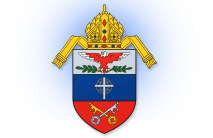
Today when one hears the term ‘field Mass’ what come to mind are liturgical events whose congregants are so numerous no enclosed edifice can contain them, such as papal Masses in stadiums or town squares. However, readers old enough to remember World War II films might associate a different image with the term. Their first exposure to a field Mass could well have been a picture of embattled soldiers kneeling in a muddy field on some front line, helmets removed, surrounding an army jeep from whose fender a priest distinguished by only a stained chasuble elevates the Sacred Host as the consecration of the Mass ensues. How strange that it never occurred to us, at least not to me, to wonder where these tireless chaplains came from. Who sent them? Who acknowledged their selfless service?
Though not as well-known as it should be the answer today is readily available. It would be the Archdiocese of the Military (AMS) erected by Pope John Paul II in 1985.
As its website indicates (www.milarch.org): “The Archdiocese for the Military Services was created by Pope John Paul II to provide the Catholic Church’s full range of pastoral ministries and spiritual services to those in the United States Armed Forces. This includes more than 220 installations in 29 countries, patients in 153 V.A. Medical Centers, and federal employees serving outside the boundaries of the USA in 134 countries. Numerically, the AMS is responsible for more than 1.8 million men, women, and children”.
In November 2007 Pope Benedict appointed Archbishop Timothy Broglio of the Diocese of Cleveland as the fourth Archbishop of the Military Services. He is supported by four Auxiliary Bishops one of whom, Bishop Joseph Coffey, is a brother of NCCF’s own board member, Jim Coffey.
Headquartered in Washington, D.C. The Archdiocese is the sole certifier of chaplains for the military services and for the Veterans Administration hospitals. Priests – who are ‘on loan’ from the dioceses where they are incardinated – become commissioned officers for as long as they serve. AMS has no parishes or parish registries. Records of sacraments performed on military installations are maintained by AMS and now number over 3.2 million. Its chapels are property of the U.S. Government from which it receives no funding. Financial support comes exclusively from chaplains, men and women in uniform and private benefactors.
The coat of arms of AMS – borne proudly on its parade banners – comprehensively represents its mission. The red, white and blue colors signify the United States; the bald eagle clutching an olive branch indicates universal peace; the silver cross mounted on a globe suggests international outreach; and the gold and silver crossed keys are the symbol of the Holy See.
Comparisons are, of course, odious. Even so I suspect that the men and women in uniform whose lives are touched by the boundless outreach of these AMS chaplains feel a certain pride and gratitude. Not just their Church but also their nation reaches out to them. One wonders if in other archdioceses the sacraments are so eagerly sought and gratefully received.
How boundless is the advance of the Kingdom?
